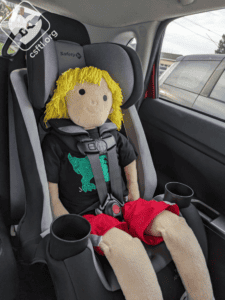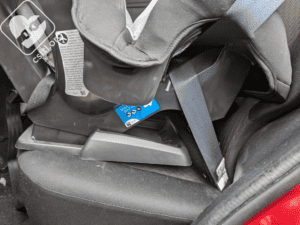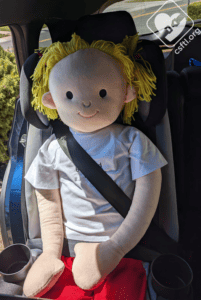Safety 1st TriMate Multimode Car Seat Review

(Last Updated On: March 5, 2024)
Safety 1st TriMate 3 year old doll forward facing
Safety 1st offers many multimode and convertible car seats already. This family of products continues to grow as different retailers request different features or price points. The latest addition to an already large family the TriMate/TriFit multimode car seat. Come along as we put this seat through the paces.
CSFTL Quick Stats
Rear facing weight range: 5-40 poundsRear facing height range: 19-40 inches tallForward facing weight range: 22 – 65 poundsForward facing height limit: 29-49 inches tallBooster mode weight range: 40 to 100 pounds and at least 4 years old. CSFTL advocates that children be at least 5 years old before moving to a booster seatBooster mode height range: 43-52 inches tallLower anchor weight limits: rear facing: 40 pounds,forward facing: 55 poundsExpiration: 10 years from date of manufacture.Crotch buckle: 3 positions — use the position closest to the child. The buckle should not be behind or underneath the child. The outermost position is only for forward-facing.
Features
No rethread harnessOptional body pillow is used for rear-facing onlyInflatable seat belt installation prohibited
Measurements
Lowest harness position: 9 inchesHighest harness position: 15.5 inchesHighest shoulder belt guide position: 17 inchesWidth at widest point:Seat weight: 12 poundsCrotch buckle positions: 5, 6.5, and 8 inches from the back of the seat pan
Rear Facing Setup and Use

Safety 1st TriMate recline angle indicator
The TriMate has 3 recline positions. Positions 2 and 3 are for rear-facing, positions 1 and 2 are for forward-facing/booster modes. In rear facing mode, the level line must be parallel to the ground if the child cannot sit up unassisted. However, if the child has adequate head/neck control, the line does not have to be even with the ground. This could mean that the seat can be installed more upright for children who fall into that category — sometimes that extra front-to-back space is a very useful thing!
Adjusting the Recline Position

Safety 1st TriMate stuck between recline positions
Normally, I don’t go very in depth about adjust a seat’s recline angle aduster but the TriMate presented a unique challenge. The seat really resisted moving between the different positions. I would have expected to squeeze the handle on the bottom of the seat’s shell with one hand, then use my other hand to move the shell into the desired position. But it took a lot more effort than that and on many occasions, I wasn’t sure the seat had moved into the next position because the adjuster was so stiff.
Recline Adjuster Stuck
I suspect that the next section (and the section above) are in direct relation to the fact that on our seat, the recline adjuster kept getting stuck. After some discussion with the manufacturer, I finally found something that worked: I had to squeeze the handle with both hands and lean on the seat’s shell with my upper body to release the adjuster. That seemed to release whatever mechanism was stuck and the recline adjuster flowed freely between positions for a while after that.
However, it wasn’t too long before that free flowing stopped and the handle got stuck in the forward facing position again. The big difference in this case was that I knew how to release it.
Flush with the Vehicle Seat

Safety 1st TriMate not flush on the vehicle seat
In many cases, placing the car seat on the vehicle seat isn’t much of a problem — you’d just set it down. But the TriMate has a rather narrow base that seems to always want to tip to one side or the other. So just getting the seat into a stable position and ready for installation was oddly difficult. And then, in forward facing mode, I was unable to install the seat with the base level to my vehicle seat. My vehicle seats are fairly flat so this is concerning, it makes me question how difficult it could be for caregivers to install this seat properly. I know I struggled more than I would have expected to. Apparenty this situation is directly related to our misbehaving angle adjuster though I assert that it’s also related to the aggressive side bolsters on my vehicle seats because the seat did sit flat on a flatter vehicle seat in a different car.
Tipping
I grew up in the Midwest and though I never participated, I heard many a tale of cow tipping. The TriMate brings my childhood back as the seat tips side to side no matter how securely I installed it. This tipping situation happened in rear and forward facing modes and it made the seat almost unusable in booster mode because it won’t sit upright as the child climbs in or buckles themselves.
At Least it’s Lightweight
The TriMate’s most redeeming quality is the fact that it isn’t particularly heavy, it only weighs 12 pounds. If it was fairly easy to install the seat well on a consistent basis, I’d suggest this as a terrific car seat for travel. But….I had so many issues installing it correctly that I can’t make that suggestion in good conscience.
Installation: Rear Facing
Vehicle Seat Belt

Safety 1st TriMate rear facing not flush with the vehicle seat
The first thing I noticed when installing this seat is that the base is so narrow, it really wants to tip over when it’s installed rear facing. I’ve got a few installation tricks up my sleeve — I tried them all and this seat still wants to tip over. So please keep that struggle in mind if you’re considering this seat.

Safety 1st TriMate rear facing not flush with the vehicle seat
To install the TriMate rear facing, set it on the vehicle seat with the harness facing the back of the vehicle. Thread the vehicle seat belt through the rear facing belt path (under the child’s legs, marked on the side of the seat’s shell) and buckle the belt. Pull the shoulder portion of the seat belt tight, then lock the belt and feed it back into the retractor. Check your work by giving the seat a firm handshake at the belt path — it shouldn’t move more than an inch in any direction.
The install you see here is solid, the seat doesn’t move when I check for movement at the belt path. However, the seat is not flush with the vehicle seat and the seat tips when I go to put my lightweight doll child into it.
Lower Anchors

Safety 1st TriMate installed rear facing with lower anchors
To install the TriMate rear facing with the lower anchors, set it on the vehicle seat with the harness facing the back of the vehicle. Thread the lower anchor connectors through the rear facing belt path (under the child’s legs, marked on the side of the seat’s shell) and connect them to the anchors in the vehicle. Pull the tail of the webbing straight up while pushing down on the car seat, remove as much slack as possible. Check your work by giving the seat a firm handshake at the belt path — it shouldn’t move more than an inch in any direction.
Installation: Forward Facing
Vehicle Seat Belt

Safety 1st TriMate forward facing not flush with vehicle seat
To install the TriMate forward facing with the vehicle seat belt, first store the lower anchor connectors by threading the connectors through the forward-facing belt path and attach connectors to storage locations on the sides of the seat. Place the top tether in the front of the car seat so it remains visible during the installation. Set the TriMate on the vehicle seat with the harness facing the front of the vehicle. Thread the vehicle seat belt through the forward facing belt path (behind the child’s back, marked on the side of the seat’s shell) and buckle. Pull the shoulder portion of the vehicle seat belt towards you while pushing the seat away from you. Lock the seat belt and feed it back into the retractor until the seat is snug. Check your work by giving the seat a firm handshake at the belt path — it shouldn’t move more than an inch in any direction.
Despite doing all of these steps and confirming that the seat doesn’t move, the base of the seat still doesn’t sit flush with the vehicle seat so my secure installation wasn’t really secure.
Lower Anchors

Safety 1st TriMate forward facing with lower anchors
The TriMate’s most notable feature is the fact that lower anchors can be used in forward facing mode until the child weighs 55 pounds. That’s longer than the lower anchor weight range for many other car seats.
To install the TriMate forward facing with the lower anchors, place the top tether in the front of the car seat so it remains visible during the installation. Set the TriMate on the vehicle seat with the harness facing the front of the vehicle. Thread the lower anchor connectors through the forward facing belt path (behind the child’s back, marked on the side of the seat’s shell) and connect them to the anchors in the vehicle. Raise the headrest all the way up for the installation, unsnap the cover to expose the belt path. Pull the tail of the webbing from inside the seat’s shell while pushing the car seat’s shell away from you. Check your work by giving the seat a firm handshake at the belt path — it shouldn’t move more than an inch in any direction.
Fit to Child
Rear Facing
Crotch Buckle J-Routing for Tiny Infants
The crotch buckle can be anchored in the middle position, then routed through the innermost position to create a smaller harness for the tiniest of passengers.
Newborn Doll

Safety 1st TriMate newborn doll with harness pads
Our Huggable Images newborn doll weighs 7 pounds and is 21 inches long. The doll appears very snug in the seat but the harness is actually above the doll’s shoulders. That’s not acceptable for a rear facing kiddo, the straps need to be at or below the shoulders.
Beyond the fact that the harness was too high for our doll, I struggled to get all of these models into the seat because it tips so much, even when it’s installed securely. The seat includes some optional and absurdly-large-for-a-newborn harness pads.
Without Harness Pads

Safety 1st TriMate newborn doll without harness pads
Here is the same doll, minus the harness pads. The fit is slightly better in this configuration but the harness is above the doll’s shoulders so the fit remains less than ideal.
3 Year Old Doll

Safety 1st TriMate 3 year old doll rear facing
Our 3 year old doll bears a striking resemblance to our 6 year old doll but is actually different. At 31 inches tall, the doll is in the middle of the seat’s height range. The harness fit the doll well, if this seat didn’t tip so much I’d say it’s a great option for this age range.
Forward Facing
6 Year Old Doll

Safety 1st TriMate forward facing 6 year old doll
Our 6 year old doll is 48 inches tall and barely weighs anything. The doll is at the very top end of the height range for this seat and it shows. The doll has pretty much outgrown the seat in harness mode.
Conversion to Booster Mode

Safety 1st TriMate booster mode
To convert the TriMate to booster mode, remove the crotch strap. Store the harness behind the headrest and seat pad. Store the lower anchor connectors in the forward-facing belt path. I will say that this process wasn’t too terribly difficult so that’s one point for the TriMate. However, the booster mode is so short-lived I have a hard time seeing any advantage of making this conversion. Note: LATCH is not permitted in booster mode.
Booster Mode
6 Year Old Doll

Safety 1st TriMate 6 year old doll booster mode
The TriMate’s highest shoulder belt guide position is 17 inches, which is rather low for a booster seat. This leads us to think that the TriMate would be outgrown pretty quickly in booster mode — families who intend to use it as a booster seat may find themselves needing a different booster seat before too long. Our 6 year old doll proves this point — the doll’s shoulder is just below the shoulder belt guide, meaning that our doll won’t be able to use this seat for much longer.
Important Information: Where to Find
Manual Storage: the manual stores on the underside of the base.

Safety 1st TriMate FAA approval label
FAA Approval: the TriMate can be used on aircraft in harnessed modes only. The label is found on the outside of the seat’s shell, near the base.

Safety 1st TriMate date of manufacture label
Date of manufacture label: the seat expires after 10 years, this information is on a label on the outside of the seat’s shell, on the base.
Overall Thoughts
I’ve written an oddly large number of car seat reviews over the years. In that time, there have only been a handful of car seats that I’ve struggled to find at least one scenario where that seat is the best option. Unfortunately, the TriMate joins that small number of seats. It’s a basic multimode seat that doesn’t do anything particularly well. The fact that it’s hard to install correctly just made everything more challenging.







